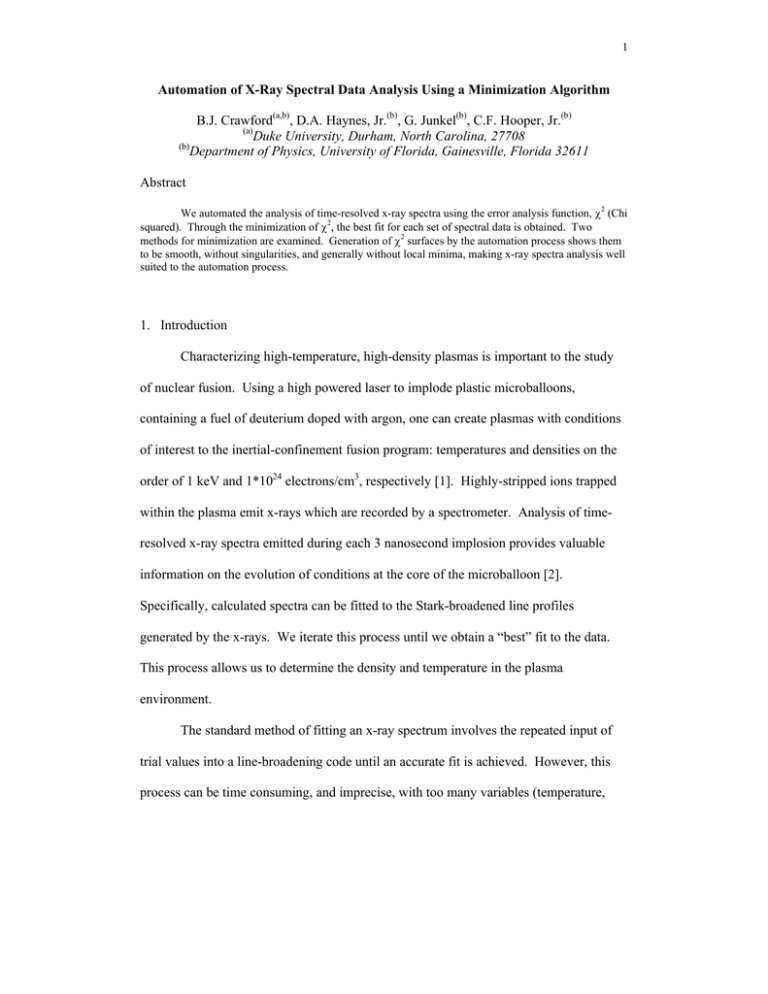Automation of X-Ray Spectral Data Analysis Using a Minimization Algorithm
advertisement

1 Automation of X-Ray Spectral Data Analysis Using a Minimization Algorithm B.J. Crawford(a,b), D.A. Haynes, Jr.(b), G. Junkel(b), C.F. Hooper, Jr.(b) (a) Duke University, Durham, North Carolina, 27708 (b) Department of Physics, University of Florida, Gainesville, Florida 32611 Abstract We automated the analysis of time-resolved x-ray spectra using the error analysis function, χ2 (Chi squared). Through the minimization of χ2, the best fit for each set of spectral data is obtained. Two methods for minimization are examined. Generation of χ2 surfaces by the automation process shows them to be smooth, without singularities, and generally without local minima, making x-ray spectra analysis well suited to the automation process. 1. Introduction Characterizing high-temperature, high-density plasmas is important to the study of nuclear fusion. Using a high powered laser to implode plastic microballoons, containing a fuel of deuterium doped with argon, one can create plasmas with conditions of interest to the inertial-confinement fusion program: temperatures and densities on the order of 1 keV and 1*1024 electrons/cm3, respectively [1]. Highly-stripped ions trapped within the plasma emit x-rays which are recorded by a spectrometer. Analysis of timeresolved x-ray spectra emitted during each 3 nanosecond implosion provides valuable information on the evolution of conditions at the core of the microballoon [2]. Specifically, calculated spectra can be fitted to the Stark-broadened line profiles generated by the x-rays. We iterate this process until we obtain a “best” fit to the data. This process allows us to determine the density and temperature in the plasma environment. The standard method of fitting an x-ray spectrum involves the repeated input of trial values into a line-broadening code until an accurate fit is achieved. However, this process can be time consuming, and imprecise, with too many variables (temperature, 2 density, and estimates for the background not included in the spectral model) to change in order to achieve the correct fit. Here we introduce a function for analyzing the error between calculated spectra and experimental data called χ2 (Chi squared). Using the χ2 function and a program for function minimization [3], it is possible to automate the process and ultimately generate better line shapes in less time than through educated guessing. In Section 2 of this paper we describe the process through which x-ray spectra are fitted, and the basis of the temperature and density inferences from these curves. We will also outline the χ2 function, and two methods of minimizing this function. In Section 3 we will compare the effectiveness of the two methods of χ2 minimization, and illustrate the pitfalls of the minimization code. In Section 4 we will present our conclusions, and suggest further courses of investigation. 2. Data Analysis Techniques 2.1. Stark Line Broadening During a particular laser driven implosion involving deuterium fuel doped with argon, the electrons from deuterium are completely stripped away, and argon, which attracts electrons more strongly, is left with one or two bound electrons. Inside the generated plasma, the radiating Argon ions are continually bombarded by particles moving at high speeds, and hence the remaining bound electrons are excited to even higher energy levels. Let us consider for a moment how an unperturbed hydrogen atom with an excited electron would behave. After a short time, the excited electron will relax back to the 3 ground state. When this relaxation occurs, energy is emitted in the form of a photon carrying a frequency proportional to the change in energy level (i.e., the photon emitted by a change from energy level 2 and that emitted from level 3 will have different frequencies). When observed by a spectrometer, we would notice the effect of one photon a given energy. If we have many hydrogen atoms, all with electrons excited to the same energy level, when they relax the spectrometer would record many photons, all with the same energy. Now, suppose we place our experiment into a uniform electric field. The uniform electric field has a polarizing effect on the orbitals of the Hydrogen atom. Each orbital within an energy level has its own dipole moment. In the presence of an electric field, every orbital either increases or decreases in energy depending on the angle between the orbital’s dipole moment and the electric field direction [4]. When these electrons relax, and are recorded by a spectrometer, we would observe many photons, each occurring at one of several discrete energies as predicted by quantum mechanics. This change in orbital energy due to the electric field is called the Stark effect [5]. We now return to the dense plasma created by the laser. Each argon ion will, in general, be subjected to a different value of the electric field, and have a different degree of energy separation due to the Stark effect. The excited argon ions relax, and when we graph the intensity versus the energy for the emitted photons we get broad lineshapes, generated by a series of delta functions spread out over different energies. The value on the Energy (eV) axis for each lineshape peak corresponds to the expected photon energy in the absence of the Stark effect. This overall effect is called Stark line broadening, and it is given by, 4 ∞ r r I (ω ) = ∫ P(ε ) J (ω , ε )dε (1) 0 r r where P (ε ) is the electric microfield probability, and J (ω , ε ) is the line profile for a r radiating ion in a uniform electric field, ε [1]. We are able to make temperature and density inferences from x-ray spectra because they are sensitive to changes in these two parameters. The photon energies that we deal with come from electrons going through 3 to 1 transitions, otherwise known as the β transitions, and 4 to 1 transitions, known as the γ transitions. When the density of a plasma increases, the local electric fields become stronger, and the orbital energy splitting becomes larger, resulting in broader lineshapes. At plasma temperatures corresponding to maximum density, each argon atom is left with only one or two bound electrons, resulting in helium-like, and hydrogen-like argon. As the temperature of a plasma increases, argon ions become more and more ionized until they reach a helium-like or hydrogen-like state, and this results in larger helium and hydrogen lines on the x-ray spectra. At relatively lower temperatures there are more Heβ and Heγ transitions because not as much argon has been ionized to the hydrogen level, and this results in the heliumlike lines being more intense than the hydrogen lines. As the temperature increases, the Hβ and Hγ lines increase in intensity, and the Heβ and Heγ lines decrease. From the ratios between these lines we can calculate the temperature at the core of the microballoon. The effects of temperature and density on a theoretical lineshape can be seen in Figure 1. By combining these two observations it possible for us to understand the evolution of temperature and density at the core of a microballoon implosion. 5 2.2. Non-Linear, Multidimensional Least Squares Fitting The method of least squares fitting, involving χ2 (Chi squared), provides a way to measure the quality of a line fit to a set of data points with some experimental uncertainty [6]. This quantity is defined as r 2 N y − Yi ( x ) χ2 = ∑ i σi i =1 (2) r where y i is the set of experimental data points, Yi (x ) is the non-linear multidimensional r theoretical line fitting function, x is a vector of parameters (in this case temperature, density, and background), and σ i is the uncertainty of each experimental data point as defined by the weight, wi , where wi = 1 [3]. Weights can be determined by a couple σ i2 of methods. Either the weight is calculated by the instrument recording the data, which records the uncertainty in each point as it collects the data, or it can be found by comparing each data point to its neighbors, and using the difference to determine a weight. If the weights are unknown, then they are all set to 1 and each point has the same effect on the χ2 function. The non-linear function to which we apply χ2 often depends on just two parameters, density and temperature. This makes it possible for the χ2 surface to be viewed in three dimensions. The surface is found to be smooth, and without singularities. If the function χ2 is linear, then it is easy to calculate its derivatives and find the minimum. However, because our function is non-linear, it is not convenient to use a method involving derivatives. We have used two different methods for finding the overall minimum in χ2 for our x-ray spectra fits. 6 2.3. Grid Minimization The first and simplest method for finding the minimum calculates the χ2 function at many points on a two dimensional grid, and finds the overall minimum within the bounds of the grid. This method is possible because we know the reasonable bounds for the temperature and density, and therefore do not have an infinite surface over which to calculate χ2. The grids start from a density of 3e23 electrons/cm3 and go to 2.1e24 electrons/cm3, by steps of 1e23 electrons/cm3, and the temperature ranged from 500 eV to 2300 eV, by steps of 100 eV. This forms a 19 × 19 grid of points at which we calculate χ2. A total of 361 calculations are needed to find the smallest value of χ2 and the best fit. These step sizes are chosen because they offer fairly good accuracy with relatively few function calls. If we were to halve the step sizes to become twice as accurate, the function calls would be quadrupled, and the program would take four times as long to complete. While this method of minimization is capable of finding the overall minimum on the grid surface, it is limited to the accuracy of its tested points, which are sometimes not as close to the actual values of temperature and density as the theory can predict. The 361 calculations involved also require a relatively long time to complete, making this method inefficient. However, it is simple to code and will not get “stuck” in local minimums on the grid surface. One of the benefits of using this method is the development of what Bevington calls a “coarse map of the behavior of χ2 as a function of all the parameters [6].” We graph the calculated points and get a good idea of the shape for the χ2 surface over the grid of temperature and density. For each different set of spectral data that we fit, the χ2 surface can look qualitatively different. For some cases the surface is very dependent on 7 temperature, for others it is sensitive to the density. Sometimes we can see that the true minimum does not lie within the grid area. Four of the χ2 surfaces can be seen in Figure 2. The most important feature that these graphs display is that the χ2 surface is smooth, contains no singularities, and rarely has local minimums. This makes it possible to use a more elegant routine for the minimization of χ2. 2.4. Simplex Method of Minimization The simplex method of function minimization does not require derivatives, only function evaluations. A simplex is a polyhedron, containing N+1 points for the N parameters to be minimized. The program for minimization, as outlined in Numerical Recipes in FORTRAN [3], is initialized by giving N+1 initial points and the χ2 function evaluation for each. Given these parameters, the program follows an algorithm for moving the initial points closer to the function minimum. The points are moved towards the minimum until the program either exceeds its maximum number of iterations, or arrives at a minimum. When all of the function values for the points are within some tolerance level, the program has reached the bottom of the χ2 surface, and is at the minimum. This simplex method is often referred to as the amoeba method because of the way that the simplex “oozes” towards the minimum [3]. The simplex method involves relatively few function calculations for the precision and quality of the fit it achieves. In our case, because there are two parameters, the simplex is a triangle. For a two parameter fit the simplex method only requires around 37 function calls, almost a factor of ten decrease from the grid method’s function calls. After the program has finished, all three of the points lie within close proximity of 8 one another, and have almost exactly the same χ2 function value. Due to the experimental error in the data, the values that the program returns are too accurate to be reasonable. The random error in each data point limits the meaningful accuracy to a range of parameter values within the area of the χ2 function minimum. The only case where the simplex method may fail is one where the program finds a local minimum instead of a global minimum. However, by looking at the fit that the simplex method returns, it is possible for us to judge whether the fit could be better, and χ2 lower, or if we already have the best possible fit. 3. Results and Discussion 3.1. Success of the Automation Process Through the use of the grid and simplex methods we have been able to automate the theoretical fitting process for x-ray spectra. Both of these programs are generally successful in producing accurate lineshapes, and they do so quickly. Perhaps one of the most important observations is that the χ2 surfaces generated by the grid method are smooth, do not contain singularities, and rarely contain local minima. This means that the automation process will most likely be successful in fitting most sets of spectral data. 3.2. Comparison of Simplex and Grid Methods Both the simplex and the grid methods of χ2 minimization are effective, but each is suited to a different task. The simplex method is effective for finding the best possible fit for an x-ray spectrum quickly, and with a great deal of accuracy. If the main objective for a fit is to uncover the core conditions of a given implosion, then the simplex method 9 is the most effective method for doing so. However, this method does not work if the χ2 surface is not smooth, or if it contains local minima. A local minimum may cause the simplex method to obtain incorrect values for temperature and density, as is shown in Figure 3. The grid method of minimization, while taking more time, does not get caught in any local minima. Although the user sacrifices precision and time when using this method, there are several benefits. The χ2 surface generated by the grid method is useful in determining which of the two parameters, temperature or density, has more impact on the fit, and also whether there are any local minima or peculiar behaviors for a set of data. It is also possible to tell if the global minimum is not on the grid surface, or if there are multiple minima with virtually the same function evaluation. When used in conjunction with one another, the simplex and grid methods are assured of giving a precise value for the temperature and density, and an accurate depiction for the overall dependency of χ2 on its parameters. 3.3 Selection of Parameters There is more to fitting x-ray spectra than just the temperature and density. Picking accurate background points is crucial to achieving the best possible fit. Normally, the user defines the background points as a piece of input, but it is possible to use the simplex method to obtain their values. The line-broadening code that we use to fit spectra uses a parabolic background specified by three user-defined points. The lineshapes are then added to this background parabola to form the overall fit. By setting three energy values for the background, and passing the intensity levels for those points as parameters, the simplex program is able to produce accurate values for the background 10 intensity. Because there are now five parameters for the simplex program to minimize, six initial points must be set. This requires a considerably longer time to complete than the usual two parameter method. For comparison purposes, while a two parameter fit may take only 37 calls, three parameters take around 70, four parameters require 130, and all five parameters take 285 function calls. If speed is not a consideration, then using the five parameter background minimization is very worthwhile, and can sometimes increase the accuracy of results by as much as 50 to 60 eV (normally around 5% to 6%). However, if speed is required, and if the user is careful in picking accurate background points, then this method may not be necessary in obtaining the values of temperature and density. The line-broadening code that generates the lineshapes for the χ2 minimization only works for values of temperature and density within certain boundaries. This has no effect on the grid method of minimization, because the program only tests points within this set range. On the other hand, the simplex method has the freedom to follow decreasing function values to wherever the minimum may lie. On some sets of data, this minimum may lie outside of the bounds of the kinetics code, and the program will crash. For this reason when the simplex method of minimization fails to obtain a minimum it is important to double check with the χ2 surface generated by the grid method to see if the global minimum may lie outside the bounds of calculation. The restraints on the linebroadening code make it impossible to fit certain spectral data accurately, particularly those having the low temperatures and densities that occur in the early stages of a microballoon implosion. 11 4. Conclusion In conclusion, we have been able to automate the fitting process for x-ray spectra. Although we have not done so here, future versions of the automated minimization should make use of weights to obtain more accurate parameter values. Even without data weighting, the automation has allowed us to obtain accurate values for the temperature and density of laser produced plasmas faster than through human trial and error. We have compared two methods for minimizing the χ2 function. The grid method generates χ2 surfaces which demonstrate the important fact that for a typical set of data there is only one value for temperature and density that produces the best fit. These χ2 surfaces are also well behaved in that they do not contain singularities, and rarely have a local minimum. The surfaces, in combination with the automated simplex method of minimization create an accurate picture for the sensitivity of a spectra to changes in temperature and density, as well as a way to quickly find the “best” fit to each set of spectral data. Supported by the National Science Foundation and hosted by the University of Florida. Special thanks to K. Ingersent and C.F. Hooper. References 1. 2. 3. 4. 5. 6. Hooper, C.F. Jr. and Mancini, R.C., “X-Ray Spectroscopy of Dense Laser Produced Plasmas,” Physica Scripta, T47, 65-69 (1993) Haynes, D.A. Jr., Garber, D.T., Hooper, C.F. Jr., Mancini, R.C., Lee, Y.T., Bradley, D.K., Delettrez, J., Epstein, R., and Jaanimagi, P.A., “Effects of ion dynamics and opacity on Starkbroadened argon line profiles,” Physical Review, 53, 1042-1050 (1995) Press, William H., Teukolsky, Saul A., Vetterling, William T. and Flannery, Brian P., Numerical Recipes for FORTAN, Second Edition, Cambridge University Press, New York, NY, 1992 Park, David, Introduction to the Quantum Theory, Second Edition, McGraw-Hill Book Company, New York, NY, 1974 Tralli, Nunzio and Pomilla, Frank R., Atomic Theory: An Introduction to Wave Mechanics, McGraw-Hill Book Company, New York, NY, 1969 Bevington, Philip R., Data Reduction and Error Analysis for the Physical Sciences, McGraw-Hill Book Company, New York, NY, 1969 12 450000 400000 (a) Intensity (arbitrary units) 350000 300000 250000 200000 150000 100000 50000 0 3550 3650 3750 3850 3950 4050 4150 Energy (eV) 450000 (b) 400000 Intensity (arbitrary units) 350000 300000 250000 200000 150000 100000 50000 0 3550 3650 3750 3850 3950 4050 4150 Energy (eV) Fig. 1. A set of experimental data points with a “best” fit done by the simplex method (solid line). The Heβ line is at around 3650 eV, the Heγ line is at around 3850 eV, the Hβ line is at around 3950 eV, and the Hγ line is at around 4150 eV. The simplex fit is plotted against (a) a theoretical line shape with accurate density, but low temperature (dotted line), (b) a theoretical line shape with accurate temperature, but low density (dotted line). In (a) please note that the He lines are more intense then the H lines. In (b) please note that the line ratios are correct, but the width is incorrect 13 (a) (b) (c) (d) Fig. 2. These four graphs show the different behaviors of the χ2 surface. For each of the graphs χ2 increases along the Z axis, density increases from left to right on the X axis, and temperature increases from left to right along the Y axis. Graph (a) shows a surface with one definite, well-defined minimum. Graph (b) shows a surface that is only sensitive to low temperatures, and after a point ceases rapidly decreasing towards the minimum. Graph (c) shows a surface where the global minimum does not lie on the grid. Graph (d) shows a surface which contains a local minimum 14 250000 (a) Intensity (arbitrary units) 200000 150000 100000 50000 0 3600 3700 3800 3900 4000 4100 4200 Energy (eV) (b) Z X Y Fig. 3. Part (a) shows a set of experimental data points with a “best” fit provided by the grid method (solid line), and a fit by the simplex method (dotted line), which is caught in a local minimum, and has come up with incorrect values for temperature and density. Part (b) shows a sliver of the χ2 surface for this set of data where the Z axis is χ2, the Y axis is density, and the X axis is temperature. The local minimum that the simplex method is caught in is on the right. The global minimum is on the left





